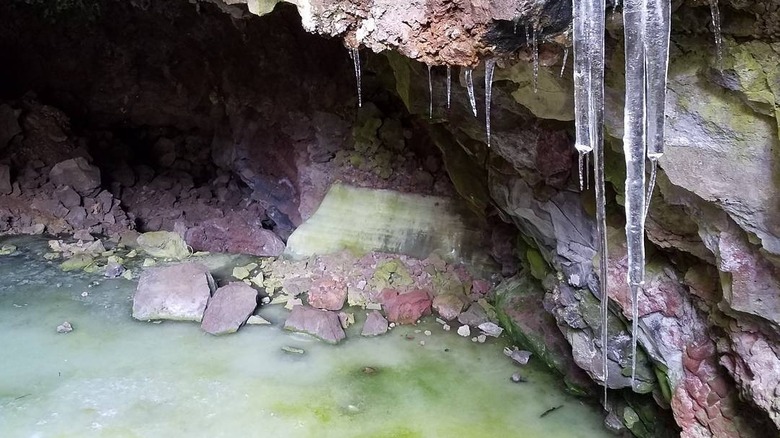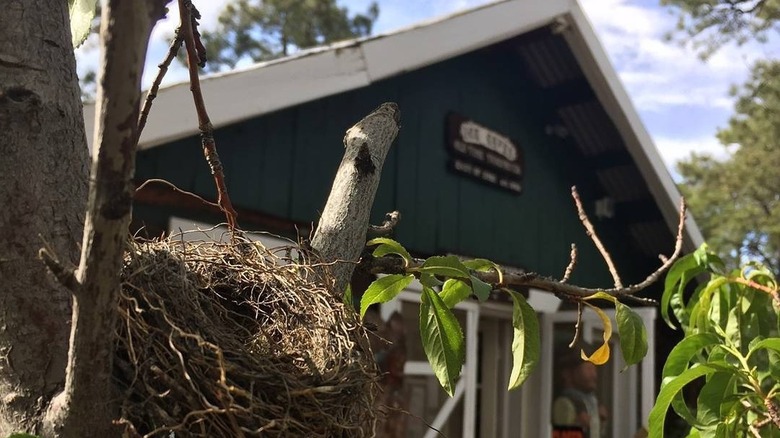New Mexico's 'Land Of Ice And Fire' Is A Volcanic Spectacle With Lava-Wrought Trails And Subterranean Marvels
In Eastern New Mexico, just outside the Ramah Navajo Indian Reservation, is "The Land of Fire and Ice." The Bandera Volcano is just one of the many cinder cones in the United States, yet combined with its Ice Cave, you have a geological marvel that only exists in a few places on the planet. While Iceland, a breathtaking destination consistently recognized as one of the safest countries, has long been considered "the land of fire and ice," the fact that such a place exists in the desert of New Mexico makes it all the more impressive.
After flying into Albuquerque International Sunport, drive west on I-40 for an hour and a half. When the desert gives way to dozens of volcanoes to the south, you're almost there. Those are the volcanoes of El Malpais National Monument, and the remnants of the Bandera Volcano rise up out of the northwest corner of El Malpais. Straddling the continental divide, Bandera is home to just two self-guided paths, but they're an impressive study in contrasts, an attraction born through flame and then filled with ice.
Bandera is just another national wonder in the Land of Enchantment. It would be a perfect day trip from Albuquerque. In fact, if you're planning a trip to New Mexico's biggest city, Bandera Volcano and Ice Cave should be at the top of your list alongside New Mexico's Cibola National Forest, which offers countless trails, views, and activities, and the mountain getaway of Jemez Hot Springs set in the state's red rocks, all of which are a relatively short drive outside Albuquerque.
Experience fire and ice at Bandera Volcano and Ice Cave
The magic at Bandera starts at the Ice Caves Trading Post, where you can pay a fee to hike the trail. Once you've paid, you can choose how you explore. Bandera's trail guide seems to suggest that you start with the fire by hiking to the volcano, but you can decide whatever order you want.
The guide explains the different types of lava you encounter along the way, and how all the lava rock formed during Bandera's last great explosion 10,000 years ago. The volcano hike is about a mile out and back; along the way, keep your eyes peeled for birds, lizards, and even snakes hiding among the ponderosa pines, junipers, and aspens rising from the igneous rock. One of the landmarks on the hike, Devil's Playground, is a rugged patch of lava known for its craggy appearance, where rattlesnakes will often be found.
After taking the longer hike to the cone born from fire, you'll want to venture a few hundred yards to the cool majesty of the Ice Cave. It's an old lava tunnel where the temperature doesn't rise above 31 degrees Fahrenheit. Because of this, all the water that finds its way into the cave turns into ice; the ice floor is estimated to be 20 feet thick. The oldest, deepest ice in the cave is 3,400 years old, meaning you're stepping way back in time just by walking into the subterranean icebox. Venturing down feels like you're descending into another world, far from the hot New Mexico desert. One can only imagine what the ancient Puebloans felt when they discovered the Ice Cave in the area later called Agua Fria, or Cold Water.
The human heritage of Bandera Volcano and Ice Cave
People have been visiting Bandera for over 1000 years, but today you enter through the Ice Caves Trading Post. There, you can check out relics of the Native Americans that have long called the area home, buy snacks or memorabilia, learn about volcanoes and the area's geology, or even go gemstone mining.
Historically, the tribes and later the settlers in the area spent their time mining ice from the cave, ending the practice in 1946. The family that currently owns it is descended from Manuel Antonio Candelaria. As an adult, he married Regina Baca, whose family had owned the land around Agua Fria. They eventually sold it to a successful New Mexico rancher who then arranged for his daughter to marry a Candelaria. In 1946, David Candelaria and his wife Reddy turned it into the tourist destination that today is still run by their daughters. David Candelaria was inducted into the New Mexico Tourism Hall of Fame for his efforts in developing and promoting Bandera in the first year the New Mexico Hospitality Association bestowed the award.
Today, the ice that was mined out is growing back. The scientific angle of the museum is augmented by exhibits of native bowls and other goods. There are themed gifts in the trading post. And not only can you hike around the cone and the Ice Cave or visit the Trading Post, you can even camp there or stay in one of their cabins. There would be no better way to truly drink in this striking geological marvel.


